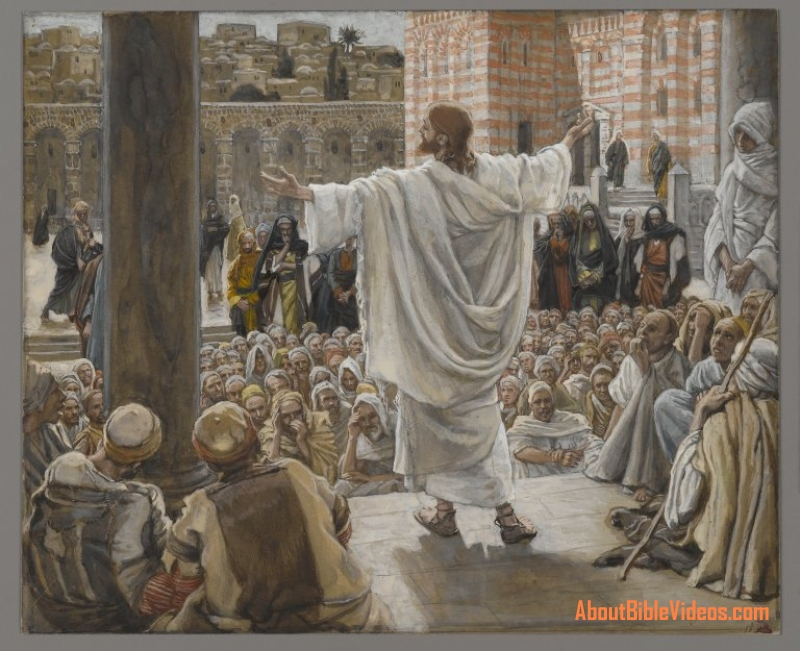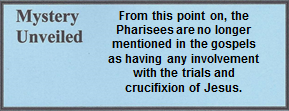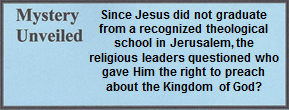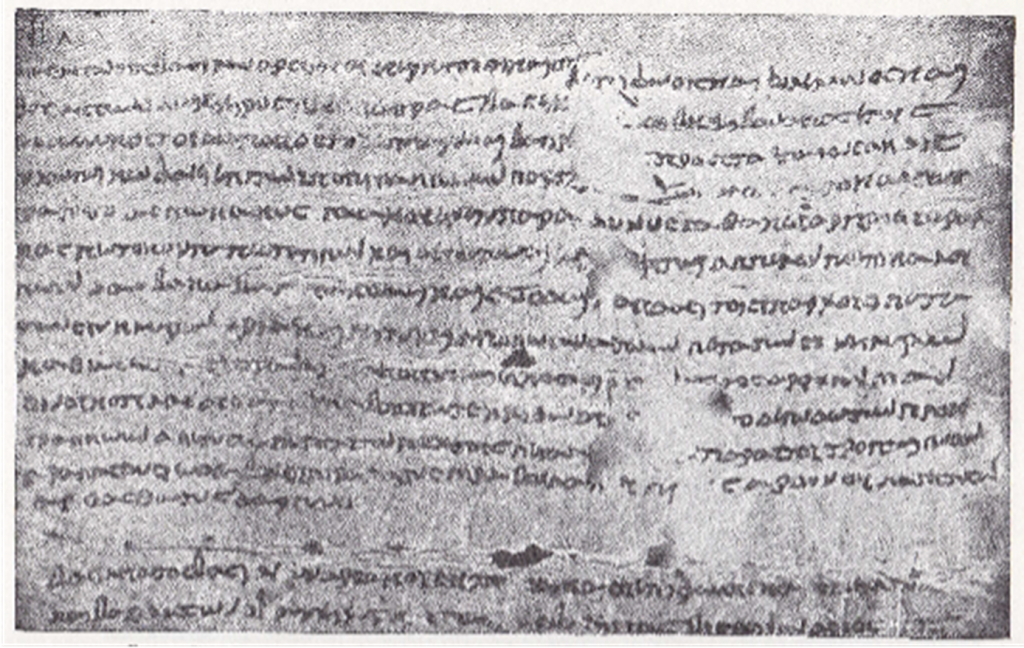13.03.07 Mt. 22:1-14
PARABLE OF THE WEDDING BANQUET / WEDDING GARMENT[1]
1 Once more Jesus spoke to them in parables: 2 “The kingdom of heaven may be compared to a king who gave a wedding banquet for his son. 3 He sent out his slaves to summon those invited to the banquet, but they didn’t want to come. 4 Again, he sent out other slaves, and said, ‘Tell those who are invited: Look, I’ve prepared my dinner; my oxen and fattened cattle have been slaughtered, and everything is ready. Come to the wedding banquet.’
5 “But they paid no attention and went away, one to his own farm, another to his business. 6 And the others seized his slaves, treated them outrageously and killed them. 7 The king was enraged, so he sent out his troops, destroyed those murderers, and burned down their city.
8 “Then he told his slaves, ‘The banquet is ready, but those who were invited were not worthy. 9 Therefore go to where the roads exit the city and invite everyone you find to the banquet.’ 10 So those slaves went out on the roads and gathered everyone they found, both evil and good. The wedding banquet was filled with guests. 11 But when the king came in to view the guests, he saw a man there who was not dressed for a wedding.
12 So he said to him, ‘Friend, how did you get in here without wedding clothes?’ The man was speechless.
13 “Then the king told the attendants, ‘Tie him up hand and foot, and throw him into the outer darkness, where there will be weeping and gnashing of teeth.’
14 “For many are invited, but few are chosen.”
This is a unique parable in that it is one of dual separation as follows:
- Separation from national Israel
- Separation from those believers who are improperly dressed for the messianic banquet
To bring clarity to this passage, examine briefly the cast of characters.
Cast of Characters
King = God
First group = The Jews who did not come
Second group = Gentiles who were not invited previously
Slaves = The prophets sent to the Jews over the centuries
Outsiders = Gentiles (non-Jews) who were invited to come
Terms
Appropriate Attire = Character of a godly person
Inappropriate Attire = Character of an unrepentant person
Separation from national Israel
The king (Jesus) gave three invitations, of which the first two went to the Jewish people.
- The first invitation was sent by the various prophets who preached the Word of God throughout the centuries, and many of them were rejected and some were even martyred.
- The second invitation to the Jewish people was by Jesus Himself, and He too was martyred.
There is an unusual element in the parable because the custom was to send out two invitations for a wedding banquet. But in this case, three invitations were sent. The third invitation was by Jesus and His apostles who went to the Gentiles. At verse 11 the second phase of this parable begins – the parable of separation. Now that the Gentiles have been invited, it is apparent that of those who responded, meaning those who became saved or said they did, not all will be permitted to the banquet. Why?
Separation from those believers who are improperly dressed for the messianic banquet
Jesus clearly stated that everyone is invited to His messianic banquet – Gentile, Jew – everyone. But He also makes a unique point that not everyone who is invited will enter into the banquet hall. An important cultural element is this: it was the custom for the wealthy and persons of high rank to provide wedding garments for those whom they invited. If anyone refused to come, or if they came but would not wear their wedding garments, they insulted the host of the banquet.[2] An important feature of this comment is that the deciding factor of who comes is not Jesus, but those people who decided not to wear their wedding garments (Gk. enduma). Those who wear appropriate attire have the character of Christ and those who do not wear the required garments are those who say they are believers, but their lives do not match their words. Just as the persons of rank showed their kindness by providing wedding garments to all the guests, the same shall be provided by the Host – the King, but those “garments” are His character.[3]
On a side note, this parable has often been used to support the doctrine of predestination, but there are two problems with this interpretation.[4]
- In predestination, it is Jesus who determines who decided before the foundation of the earth who goes to heaven or who goes to hell. In this parable, as in others, the decision is left to the individual.
- A standard rule of Jewish hermeneutics is that parables are never to be used for the establishment of doctrine.
A wedding was always a time for great celebration, as it was seen as the beginning of a new family. The “dinner” of verse 4 was not the evening meal, but the noon-breakfast or luncheon meal[5] which enabled the attendees to enjoy fellowship for the rest of the day. The custom of the time required that literally everyone be invited, including those living in remote areas and byways (verses 9-10).[6]
Again, it is evident Jesus used a parable that was of common knowledge to the people. The one He presented was similar to a story of the rabbis and recorded in the Babylonian Talmud. In the Jewish culture it was customary for any good rabbi, when teaching a lesson in the form of a parable to give an explanation. Jesus was a Master Teacher who followed the cultural norm in this regard. From rabbinic literature is an example of a “king” parable:
The matter may be compared to a king who arranged a banquet and invited guests to it. The king issued a decree which stated: “Each guest must bring something on which to recline.” Some brought carpets, others brought mattresses or pads or cushions or stools, while still others brought logs or stones. The king observed what they had done, and said, “Let each man sit on what he brought.” Those who had to sit on wood or stone murmured against the king. They said, “Is it respectful for the king, that we, his guests, should be seated on wood and stone?” When the king heard this, he said to them, “It is not enough that you have disgraced with your wood and stone the palace which was erected for me at great cost, but you dare to invent a complaint against me! The lack of respect paid to you is the result of your own action.”
Similarity, in the Hereafter, the wicked will be sentenced to Gehenna and will murmur against the Holy One, blessed be He, saying, “We sought His salvation. How could such a fate befall us?” He will answer them, “When you were on the earth, did you not quarrel and slander and do evil? Were you not responsible for strife and violence? That is why it is written, ‘All you that kindle a fire, that encircle yourselves with firebrands, walk in the flame of your fire and among the brands that you have kindled’ (Isaiah 50:11). If you say, ‘This we have from your hand,’ it is not so; you have brought it on yourselves and, therefore, ‘you will lie down in torment.’”
Babylonian Talmud, Shabbath 153b
The matter may be compared to a king who arranged a banquet and invited guests to it. The king issued a decree, but the people complained and did not show the respect that was due to a king. Similarity, in the hereafter, the wicked will be sentenced to Gehenna and will murmur against the Holy One Blessed Be He, saying,
“We sought His salvation. How could such a fate befall us?” He will answer them, “When you were on the earth, did you not quarrel and slander and do evil? Were you not responsible for strife and violence? That is why it is written, ‘All you that kindle a fire, that encircle yourselves with firebrands, walk in the flame of your fire and among the brands that you have kindled’ (Isa. 50:11). If you say, ‘This we have from your hand,’ it is not so; you have brought it on yourselves and, therefore, ‘you will lie down in torment.’”
Ecclesiates Rabbah 3:9
In the parable of Jesus, the Jews were the guests of honor at the banquet. They received their invitation by the Hebrew prophets. But by the time Jesus came onto the scene, they had convinced themselves that they would be the only persons at the heavenly wedding banquet, so they did not come to the hallowed event. Therefore, the host of the banquet sent other servants again to invite guests, and after another poor response, the host finally invited anybody and everybody. However, when the host saw that some of the attendees were not wearing wedding clothes, he threw them out.
Finally, some commentators have observed the parallel of this narrative with the historical event when a Jewish delegation went to Rome and objected to Augustus the succession of Archelaus after the death of Herod the Great.[7] Clearly, when Jesus told a parable, He structured it so the people would understand and remember what He taught.
“He sent out his troops, destroyed those murderers, and burned down their city.” While the Jews believed they would be the only chosen people at this event, Jesus completely upset their theology. Four decades later the Romans besieged the Holy City, murdered thousands, and burned the temple.
“Wedding clothes.” As previously stated, persons of wealth or high rank showed their magnificence by providing wedding garments to their guests.[8] In this context, the wedding garments are symbolic of righteousness provided by God’s gracious character. However, concerning the one who rejected the garments, Jesus reflected upon the words of the prophet Hosea, who said,
What will you do on a festival day,
on the day of the Lord’s feast?
Hosea 9:5
Jesus said that one must be ready at all times for the messianic banquet. But while many are aware of the coming wedding, few will do what is necessary to be prepared for the event.
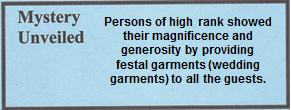
“For many are invited, but few are chosen.” Those who are “invited” or “called” as some translations read, are simply those who heard and accepted the invitation of salvation. Those who are “chosen” did the same but continued their Christian lifestyle and obeyed His Word. This passage has often been incorrectly been interpreted to either support or deny the doctrine of predestination. As previously stated, the standard rule of hermeneutics is that parables are not used to support or deny doctrines.
13.03.07.Q1 Was Jesus familiar with non-biblical literary sources?
To the modern reader, the answer might be an affirmative – yes. However, Jesus lived in an oral tradition culture where stories were handed down from generation to generation. Within such a culture, great care is taken to insure that the historical accounts are transmitted accurately – a skill and tradition that has been lost in today’s modern Western culture. Therefore, when Jesus referred to an account that may have been written in the book of Tobit, He probably was familiar with it by way of oral tradition. At this time, writing materials were extremely expensive and difficult to acquire. So rabbis had to memorize great volumes of Scriptures and extra-biblical books.[9]
Jesus was typical of orthodox rabbis of His period. They all taught the same basic truth and only in a few instances did Jesus introduce new elements into His sermons. Of course, the most dramatic of these elements was the eventual proclamation of Messiahship. Modern students at times conclude, since Jesus did not lie, that every story or parable Jesus told was an actual historical event. But as a Master Teacher, He would four sources to illustrate a point:
- Historical events
- Word plays on a legend known to everyone
- Stories to teach a lesson
- Reflections on an Old Testament story
All orthodox rabbis used these elements in their instructional lessons. An example is found in 2 Samuel 12:1-4 where Nathan told King David the famous parable of a rich man who had many sheep but took the lamb of the poor man. The account was so real to life that David was ready to kill the rich man, only to learn that the prophet spoke of David himself. Likewise, rabbis as well as Jesus also used story parables to touch the hearts of men. To create a story that presented a truth never meant that the story was a historical event.
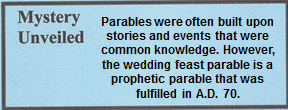
[1]. The significance of the messianic banquet was very important to Jesus (Heb. Yeshua). The wedding imagery between Himself and His church as it was reflected in a first century Jewish wedding is discussed by Dr. John Fischer, a messianic scholar and rabbi in video 09.03.04.V1 and Professor John Metzger in video 14.02.05.V2. See the following as well: Discussion of the “best place” in Lk. 14:7-14 (12.02.05); the great messianic banquet in Lk. 14:15-24 (12.02.06); the wise and foolish virgins in Mt. 25:1-13 (14.01.07); only the father knew Mt. 24:36 (14.01.05); the preparation of a new home in Jn. 14:1-4 (14.02.14).
[2]. Lang, Know the Words of Jesus. 243-44.
[3]. Geikie, The Life and Words of Christ. 2:414-15; Vine, “Marriage, Marry.” Vine’s Complete Expository Dictionary. 2:394.
[4]. Lang, Know the Words of Jesus. 244.
[5]. Scholars debate as to when the wedding feast was served. Some say it was an evening meal. Vincent, Word Studies in the New Testament. 1:119.
[6]. Vincent, Word Studies in the New Testament. 1:120.
[7]. Josephus, Antiquities 17.11.1.
[8]. Vine, “Garment.” Vine’s Complete Expository Dictionary. 2:261, and “Marriage, Marry.” 2:394-95. See video 09.03.04.V1 by Messianic Rabbi John Fischer who discusses first century wedding imagery, and video 14.02.05.V2 by Professor John Metzger who discusses the Passover, the Last Supper and its implications to the Messianic Banquet.
[9]. This dedication to study and memorize might explain why today, the Jewish people who comprise only one-half of one percent, have attained an outstanding twenty-two percent of the Nobel Peace Prizes.
